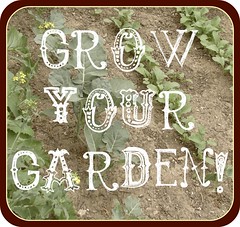 In the introduction to my Grow Your Garden series, I shared reasons people garden. I hope you have nailed down some inspiration because now it's time to plan in earnest!
My first principle of garden planning is to grow what you want to eat. This sounds simple, but sometimes people plant what's available or what their mother planted but it's not something they actually want to consume. Just last year, we planted a big row of radishes. After harvesting just a few plants we determined we don't actually eat them and gave away the rest.
In the introduction to my Grow Your Garden series, I shared reasons people garden. I hope you have nailed down some inspiration because now it's time to plan in earnest!
My first principle of garden planning is to grow what you want to eat. This sounds simple, but sometimes people plant what's available or what their mother planted but it's not something they actually want to consume. Just last year, we planted a big row of radishes. After harvesting just a few plants we determined we don't actually eat them and gave away the rest.
Next, consider what will grow well in the conditions and space you have. Below are some suggestions:
Plants ideal for containers:
- lettuces
- greens
- herbs
- tomatos and peppers (BIG containers)
Plants well suited to small spaces:
- kale
- chard
- radishes
- garlic
- beets
- herbs
- lettuce
Plants which can be trellised vertically:
- peas
- beans
- cucumbers
- squashes
- melons
Excellent producers in Ohio conditions:
- tomatos
- cucumbers
- beans
- summer squash
- zucchini
- kale
- chard
- peppers
- raspberries
So, make a list of which fruits and vegetables you love to eat and want to grow.
Next it's time to purchase seeds! I recommend looking through an online or print seed catalog like to determine which varieties you like. I have been very happy with the seed quality and customer service of the Seeds of Change online store. Heirloom varieties typically grow very well in the home garden. Many gardeners prefer non hybrid seeds so that they may save seeds for the following year.
If you have the chance, ask a gardening friend or neighbor if they have any seeds to share. Most of us gardeners have a huge collection of seed packets we are more than happy to share. I have yet to use old seeds that don't germinate, but I do recommend planting a few extras if you are using dated seeds.
If this is your first year gardening, consider purchasing seedlings instead of starting seeds indoors. Seed starting is not hard, but it does require significant time and money investment. You will probably want to focus those resources on building beds.
Many seeds will be directly sown in the ground, such as peas, beans, lettuces, greens, onion sets, potatoes, squashes, and sunflowers. These are perhaps the easiest to grow because you just dip seeds in the soil and watch them produce.
This year I am growing potatoes, onions, garlic (already planted), winter squash, tomatos, peppers, spinach, four season lettuce, beets, quinoa, basil, oregano, sage, thyme (hoping it overwinters), two kinds of beans, peas, and pumpkin. Please don't let me forget to plant pumpkin. Of these, the only seeds I will purchase are quinoa, a beefsteak type tomato, and potatoes. If you also want to grow potatoes, look for my next post about our group seed potato buy!
What do you plan to grow?
Next in the series, I'll share advice about planning your garden beds followed by seed starting.


 Edible gardening in an art and science that my family loves. It
Edible gardening in an art and science that my family loves. It